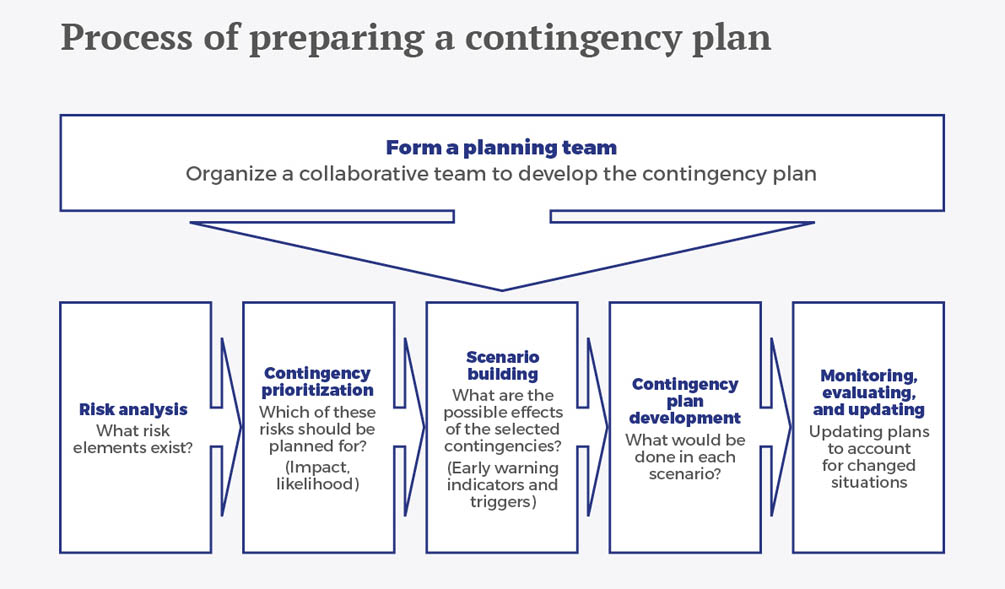Across the globe, crises such as disease, drought, or flooding happen recurrently but their impact varies every year. Contingency planning is an effective approach for dealing with situations of such uncertainty and seriousness.
According to the United Nations Office for Disaster Risk Reduction (UNDRR), a contingency plan is a management process that analyzes specific potential events or emerging situations that might threaten society. These plans establish arrangements in advance to enable timely, effective, and appropriate responses to such events and situations.
Stakeholders work together to identify potential crisis scenarios and develop a shared understanding about the risk, helping to establish a common set of principles and mechanisms on how to make decisions during a potential crisis.
Preparation of the plan
In order to design and implement a contingency plan, it is important to choose a collaborative team that includes experts from all relevant units of an organization, as well as civil society representatives if the plan targets a particular region. The team should build relationships, collaboration, and confidence, which can lead to understanding, with the aim of obtaining a better response in the event of an emergency. The process of preparing a contingency plan is shown in the following chart:

How is it structured?
A contingency plan can be divided into three main sections:
- Basic plan: The basic plan provides an overview of the organization’s approach to emergency operations and describes the purpose, scope, and general emergency coordination (information and communication, finance, logistics, etc.).
- Contingency-specific responses: This describes the best and worst scenarios for the contingencies prioritized, establishes early warning indicators and triggers, and defines the resources and functions required for particular hazards.
- Emergency support functions: This section describes the expected mission execution for various functions (e.g. communication, finance, IT, marketing) and identifies tasks assigned to the person responsible in each case.
Basic plan
First, the basic plan should describe the most important aspects of any emergency coordination. Who has the authority to activate the plan or to make certain decisions? Who should be responsible for directing different response activities (and who can they delegate responsibility to)? How will they coordinate amongst themselves This could be a task force formed of representatives of different departments who meet daily to coordinate and make decisions based on the changing circumstances.
Furthermore, it is important to manage the collection and communication of information. What are the main mechanisms used to identify and assess the needs of your community, your clients, or your staff? What are the alert and warning mechanisms at the institution?
Defining potential emergency funding sources is key, as well as the logistics and management mechanisms used to identify and acquire resources in advance and during emergency operations, especially to overcome gaps in capacity. What resources are needed? What resources are available? What are the different processes and timelines for allocating resources and who oversees these processes?
Finally, we need to know the main aspects and factors of our risk. What is the location, intensity, frequency, and probability of the main hazard(s)? How great is our exposure and vulnerability? What are our main coping mechanisms and capacities?
Specific responses
Second, we need to analyze contingency-specific responses. We need to provide details of the probable impact and negative consequences of each contingency, that is, the characteristics of the different potential scenarios, including the number of people affected in different population groups and the various negative effects and losses for society and the organization. This allows us to estimate various planning assumptions for likely needs, in terms of both response capacity and resource necessities.
Early warning indicators and triggers for action based on realistic startup times for emergency interventions should also be included here. A number of quantitative or qualitative early warning indicators, triggers, and emergency support functions should be identified for each scenario, and it is key to provide information about the resources required to respond to the emergency in each case.
Support functions
Third, we must take into account the emergency support functions (ESFs) to define the critical operational functions necessary for an emergency response. Each ESF should include a description of the processes, roles, and responsibilities that the respective departments or stakeholders should carry out for preparedness and to achieve early recovery from a likely crisis. For example, a national government, will have varying responsibilities and tasks for the areas of defense, health, transport and mobility, foreign affairs, economy, and others; whereas a sales company, could be divided into marketing, communication, finance, and IT.
Each ESF should include a checklist of actions identifying and describing the actions that will be taken in the event of an emergency (response and early recovery) as well as activities to be taken before the incident (preparedness).
Regular updates and improvements
Finally, contingency plans should be adapted to the current situation to ensure the efficient, effective, and equitable use of resources.
Even when responding to an emergency, potential future must be considered. This may not be traditional long-term planning, but it is a strong contingency planning proposal.
